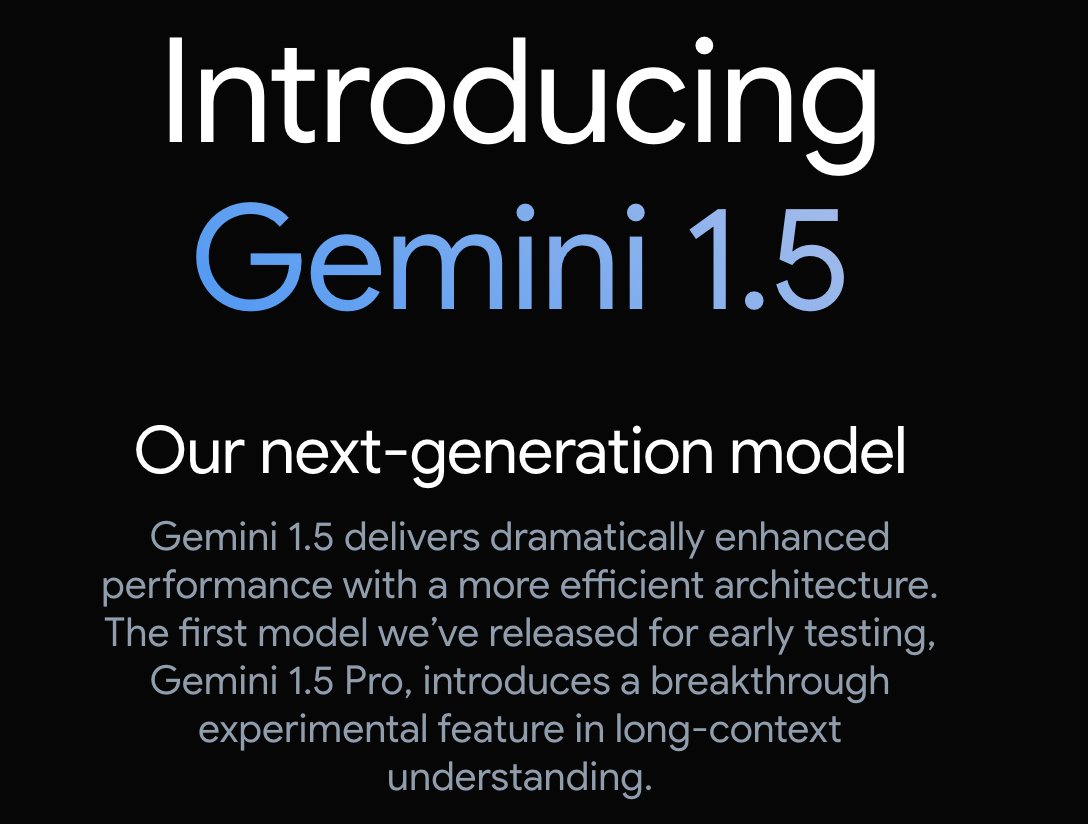
February 16, 2024
Google Releases Gemini 1.5 With 10M Context Window
Google has released its next-generation AI model, Gemini 1.5. It is a significant advancement over the previous model, Gemini 1.0 Ultra, and offers dramatic improvements across various dimensions. Gemini 1.5 Pro, the first model released for early testing, achieves comparable quality to 1.0 Ultra while using less compute. This is just 2 months after the initial release of Gemini.

One of the key breakthroughs is its long-context understanding, with a capacity to process up to 1 million tokens, enabling entirely new capabilities and applications for developers and enterprise customers. The model is built upon leading research on Transformer and Mixture-of-Experts (MoE) architecture, making it more efficient to train and serve. It also delivers enhanced performance, outperforming its predecessor on 87% of the benchmarks used for developing large language models (LLMs). Additionally, extensive ethics and safety testing have been conducted to ensure responsible deployment of the model.
Gemini 1.5 is Here
This is one of the most shocking examples:
With only instructional materials (500 pages of linguistic documentation, a dictionary, and ≈ 400 parallel sentences) all provided in context, Gemini 1.5 Pro is capable of learning to translate from English to Kalamang, a language spoken by fewer than 200 speakers in western New Guinea in the east of Indonesian Papua2 , and therefore almost no online presence. Moreover, we find that the quality of its translations is comparable to that of a person who has learned from the same materials.
– Gemini 1.5 is Google’s next-generation AI model, offering significant improvements over the previous model, Gemini 1.0 Ultra.
– It achieves comparable quality to 1.0 Ultra while using less compute and introduces a breakthrough in long-context understanding, with a capacity to process up to 1 million tokens.
Architecture
Gemini 1.5 is a state-of-the-art deep learning model built on top of cutting-edge research in Transformer and MoE (Model Parallelism with Experts) architectures. Unlike traditional Transformers that use one large neural network, MoE models are composed of smaller “expert” networks.
MoE models dynamically activate only the most relevant expert pathways within their neural network based on the input they receive, significantly improving efficiency compared to conventional approaches. Google has been at the forefront of developing and implementing MoE techniques for deep learning through various groundbreaking research papers like Sparsely-Gated MoE, GShard-Transformer, Switch-Transformer, M4, and more.
Gemini 1.5 leverages these advancements in model architecture to learn complex tasks faster while maintaining high-quality results. It is also more efficient during both training and serving phases. These efficiencies enable our teams to iterate quickly, train advanced versions of Gemini rapidly, and continue working towards further optimizations.
Impressive Context lengths
The Impressive Context lengths of Gemini 1.5 cannot be overstated, especially when it pertains to navigating the complex and dense world of codebases. With the ability to process up to 1 million tokens, which is over 30K lines of code, it now means the model has dramatically expanded the horizon of possibilities for software development and maintenance. Programmers and engineers can now leverage this AI to understand and work with larger sections of code in a single instance, allowing for a more comprehensive analysis and quicker troubleshooting. Not only that but equally if not more impressive is its near-perfect retrieval accuracy. This ensures that the most relevant and useful information is available when needed, minimizing the risk of overlooking crucial details inherent in massive code repositories and hallucinations.

This technological leap places significant competitive pressure on Retrieval-Augmented Generation (RAG) models, which may struggle to keep up with the vast context window and precision of Gemini 1.5. Google’s tech report suggests that performance remains robust even when scaling up to staggering sizes like 10 million tokens. As developers embrace this expansion in context size, they’re unlocking opportunities for AI-assisted programming that were once considered science fiction. However, the cost of managing such a voluminous stream of tokens remains a topic for discussion. The financial and computational resources required to sustain these capabilities are substantial, and whether they justify the benefits is yet to be seen. Additionally, the future of Gemini hints at an evolution toward multi-modal learning, with plans to ingest various media types such as files and videos, further enriching the context and utility of the AI — a step beyond its current limitation to image inputs.